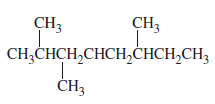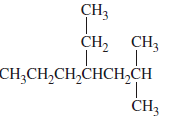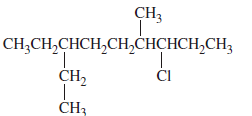
General Chemistry: Principles and Modern Applications (11th Edition)
11th Edition
ISBN: 9780132931281
Author: Ralph H. Petrucci, F. Geoffrey Herring, Jeffry D. Madura, Carey Bissonnette
Publisher: PEARSON
expand_more
expand_more
format_list_bulleted
Concept explainers
Question
Chapter 26, Problem 31E
Interpretation Introduction
(a)
Interpretation:
An acceptable name for the following compound should be determined:

Concept introduction:
Rules for the nomenclature of branched hydrocarbons,
- select the longest continuous carbon chain.
- Identify all the substituent
- Number the parent chain from the end that gives the substituents the lowest number.
- If the same substituent occurs more than once, location of each substituent is given and the number is indicated by a prefix.
- Substituents are named in alphabetical order.
Interpretation Introduction
(b)
Interpretation:
An acceptable name for the following compound should be determined:

Concept introduction:
Rules for the nomenclature of branched hydrocarbons,
- select the longest continuous carbon chain.
- Identify all the substituent
- Number the parent chain from the end that gives the substituents the lowest number.
- If the same substituent occurs more than once, location of each substituent is given and the number is indicated by a prefix.
- Substituents are named in alphabetical order.
Interpretation Introduction
(c)
Interpretation:
An acceptable name for the following compound should be determined:

Concept introduction:
Rules for the nomenclature of branched hydrocarbons,
- select the longest continuous carbon chain.
- Identify all the substituent
- Number the parent chain from the end that gives the substituents the lowest number.
- If the same substituent occurs more than once, location of each substituent is given and the number is indicated by a prefix.
- Substituents are named in alphabetical order.
Interpretation Introduction
(d)
Interpretation:
An acceptable name for the following compound should be determined:

Concept introduction:
Rules for the nomenclature of branched hydrocarbons,
- select the longest continuous carbon chain.
- Identify all the substituent
- Number the parent chain from the end that gives the substituents the lowest number.
- If the same substituent occurs more than once, location of each substituent is given and the number is indicated by a prefix.
- Substituents are named in alphabetical order.
Expert Solution & Answer
Want to see the full answer?
Check out a sample textbook solution
Students have asked these similar questions
You are trying to decide if there is a single reagent you can add that will make the following synthesis possible without any other major side products:
xi
1. ☑
2. H₂O
хе
i
Draw the missing reagent X you think will make this synthesis work in the drawing area below.
If there is no reagent that will make your desired product in good yield or without complications, just check the box under the drawing area and leave it blank.
Click and drag to start drawing a
structure.
There is no reagent that will make this synthesis work without complications.
: ☐
S
☐
Predict the major products of this organic reaction:
H
OH
1. LiAlH4
2. H₂O
?
Note: be sure you use dash and wedge bonds when necessary, for example to distinguish between major products with different stereochemistry.
Click and drag to start drawing a
structure.
G
C
टे
For each reaction below, decide if the first stable organic product that forms in solution will create a new C-C bond, and check the appropriate box.
Next, for each reaction to which you answered "Yes" to in the table, draw this product in the drawing area below.
Note for advanced students: for this problem, don't worry if you think this product will continue to react under the current conditions - just focus on the first
stable product you expect to form in solution.
NH2
CI
MgCl
?
Will the first product that forms in this reaction
create a new CC bond?
Yes
No
MgBr
?
Will the first product that forms in this reaction
create a new CC bond?
Yes
No
G
टे
Chapter 26 Solutions
General Chemistry: Principles and Modern Applications (11th Edition)
Ch. 26 - Prob. 1ECh. 26 - Draw a structural formula for each of the...Ch. 26 - Prob. 3ECh. 26 - Write structural formulas corresponding to these...Ch. 26 - Prob. 5ECh. 26 - Prob. 6ECh. 26 - Prob. 7ECh. 26 - Prob. 8ECh. 26 - What is the relationship, if any, between the...Ch. 26 - Prob. 10E
Ch. 26 - Prob. 11ECh. 26 - Prob. 12ECh. 26 - Identify the chiral carbon atoms, ¡f any, in the...Ch. 26 - Prob. 14ECh. 26 - Identify the chiral carbon atoms, ¡f any, in the...Ch. 26 - Prob. 16ECh. 26 - Prob. 17ECh. 26 - Prob. 18ECh. 26 - Prob. 19ECh. 26 - By name or formula, give one example of each of...Ch. 26 - Prob. 21ECh. 26 - Prob. 22ECh. 26 - Prob. 23ECh. 26 - Prob. 24ECh. 26 - Prob. 25ECh. 26 - Prob. 26ECh. 26 - Prob. 27ECh. 26 - Prob. 28ECh. 26 - Prob. 29ECh. 26 - Prob. 30ECh. 26 - Prob. 31ECh. 26 - Prob. 32ECh. 26 - Prob. 33ECh. 26 - Prob. 34ECh. 26 - Does each of the following names convey sufficient...Ch. 26 - Prob. 36ECh. 26 - Prob. 37ECh. 26 - Supply condensed structural formulas for the...Ch. 26 - Prob. 39ECh. 26 - Prob. 40ECh. 26 - Classify the carbon atoms in, a. methylbutane, and...Ch. 26 - Classity the carbon atoms in a....Ch. 26 - Prob. 43ECh. 26 - Draw Newman projections for the staggered and...Ch. 26 - Draw the most stable conformation for the molecule...Ch. 26 - Prob. 46ECh. 26 - Prob. 47ECh. 26 - Prob. 48ECh. 26 - Prob. 49ECh. 26 - Prob. 50ECh. 26 - Prob. 51ECh. 26 - Prob. 52ECh. 26 - Prob. 53ECh. 26 - Prob. 54ECh. 26 - Prob. 55ECh. 26 - Prob. 56ECh. 26 - Draw suitable structural formulas to show that...Ch. 26 - Which of the following pairs of molecules are...Ch. 26 - Prob. 59ECh. 26 - Prob. 60ECh. 26 - Name the following molecules with the appropriate...Ch. 26 - Name the following molecules with the appropriate...Ch. 26 - Name the following molecules with the appropriate...Ch. 26 - Prob. 64ECh. 26 - Draw the structure for each of the following. a....Ch. 26 - Prob. 66ECh. 26 - Prob. 67ECh. 26 - Prob. 68ECh. 26 - Prob. 69ECh. 26 - Prob. 70ECh. 26 - Prob. 71ECh. 26 - Prob. 72ECh. 26 - Prob. 73ECh. 26 - Prob. 74ECh. 26 - Supply condensed or structural formulas for the...Ch. 26 - Prob. 76IAECh. 26 - Prob. 77IAECh. 26 - Prob. 78IAECh. 26 - Prob. 79IAECh. 26 - Prob. 80IAECh. 26 - Combustion of a 0.1908 g sample of a compound gave...Ch. 26 - Prob. 82IAECh. 26 - In the monochiorination of hydrocarbons, a...Ch. 26 - A particular colorless organic liquid is known to...Ch. 26 - Prob. 85IAECh. 26 - Give the systematic names, including any...Ch. 26 - Prob. 87IAECh. 26 - Prob. 88IAECh. 26 - Levomethadyl acetate (shown below) is used in the...Ch. 26 - Thiamphenicol (shown below) is an antibacterial...Ch. 26 - Prob. 91IAECh. 26 - Prob. 92IAECh. 26 - Prob. 93IAECh. 26 - Prob. 94IAECh. 26 - Prob. 95IAECh. 26 - For each of the following molecules (a) draw the...Ch. 26 - Prob. 97FPCh. 26 - Prob. 98SAECh. 26 - Explain the important distinctions between each...Ch. 26 - Describe the characteristics of each of the...Ch. 26 - The compound isoheptane is best represented by the...Ch. 26 - Prob. 102SAECh. 26 - Prob. 103SAECh. 26 - Prob. 104SAECh. 26 - Assign configurations, R or S, to the chiral...Ch. 26 - Consider the following pairs of structures In each...Ch. 26 - Prob. 107SAECh. 26 - Prob. 108SAECh. 26 - Prob. 109SAECh. 26 - Prob. 110SAECh. 26 - Prob. 111SAE
Knowledge Booster
Learn more about
Need a deep-dive on the concept behind this application? Look no further. Learn more about this topic, chemistry and related others by exploring similar questions and additional content below.Similar questions
- For each reaction below, decide if the first stable organic product that forms in solution will create a new CC bond, and check the appropriate box. Next, for each reaction to which you answered "Yes" to in the table, draw this product in the drawing area below. Note for advanced students: for this problem, don't worry if you think this product will continue to react under the current conditions - just focus on the first stable product you expect to form in solution. དྲ。 ✗MgBr ? O CI Will the first product that forms in this reaction create a new C-C bond? Yes No • ? Will the first product that forms in this reaction create a new CC bond? Yes No × : ☐ Xarrow_forwardPredict the major products of this organic reaction: OH NaBH4 H ? CH3OH Note: be sure you use dash and wedge bonds when necessary, for example to distinguish between major products with different stereochemistry. Click and drag to start drawing a structure. ☐ : Sarrow_forwardPredict the major products of this organic reaction: 1. LIAIHA 2. H₂O ? Note: be sure you use dash and wedge bonds when necessary, for example to distinguish between major products with different stereochemistry. Click and drag to start drawing a structure. X : ☐arrow_forward
- For each reaction below, decide if the first stable organic product that forms in solution will create a new C - C bond, and check the appropriate box. Next, for each reaction to which you answered "Yes" to in the table, draw this product in the drawing area below. Note for advanced students: for this problem, don't worry if you think this product will continue to react under the current conditions - just focus on the first stable product you expect to form in solution. NH2 tu ? ? OH Will the first product that forms in this reaction create a new CC bond? Yes No Will the first product that forms in this reaction create a new CC bond? Yes No C $ ©arrow_forwardAs the lead product manager at OrganometALEKS Industries, you are trying to decide if the following reaction will make a molecule with a new C-C bond as its major product: 1. MgCl ? 2. H₂O* If this reaction will work, draw the major organic product or products you would expect in the drawing area below. If there's more than one major product, you can draw them in any arrangement you like. Be sure you use wedge and dash bonds if necessary, for example to distinguish between major products with different stereochemistry. If the major products of this reaction won't have a new CC bond, just check the box under the drawing area and leave it blank. Click and drag to start drawing a structure. This reaction will not make a product with a new CC bond. G marrow_forwardIncluding activity coefficients, find [Hg22+] in saturated Hg2Br2 in 0.00100 M NH4 Ksp Hg2Br2 = 5.6×10-23.arrow_forward
- give example for the following(by equation) a. Converting a water insoluble compound to a soluble one. b. Diazotization reaction form diazonium salt c. coupling reaction of a diazonium salt d. indacator properties of MO e. Diazotization ( diazonium salt of bromobenzene)arrow_forward2-Propanone and ethyllithium are mixed and subsequently acid hydrolyzed. Draw and name the structures of the products.arrow_forward(Methanesulfinyl)methane is reacted with NaH, and then with acetophenone. Draw and name the structures of the products.arrow_forward
- 3-Oxo-butanenitrile and (E)-2-butenal are mixed with sodium ethoxide in ethanol. Draw and name the structures of the products.arrow_forwardWhat is the reason of the following(use equations if possible) a.) In MO preperation through diazotization: Addition of sodium nitrite in acidfied solution in order to form diazonium salt b.) in MO experiment: addition of sodium hydroxide solution in the last step to isolate the product MO. What is the color of MO at low pH c.) In MO experiment: addition of sodium hydroxide solution in the last step to isolate the product MO. What is the color of MO at pH 4.5 d.) Avoiding not cooling down the reaction mixture when preparing the diazonium salt e.) Cbvcarrow_forwardA 0.552-g sample of an unknown acid was dissolved in water to a total volume of 20.0 mL. This sample was titrated with 0.1103 M KOH. The equivalence point occurred at 29.42 mL base added. The pH of the solution at 10.0 mL base added was 3.72. Determine the molar mass of the acid. Determine the Ka of the acid.arrow_forward
arrow_back_ios
SEE MORE QUESTIONS
arrow_forward_ios
Recommended textbooks for you

 Chemistry for Today: General, Organic, and Bioche...ChemistryISBN:9781305960060Author:Spencer L. Seager, Michael R. Slabaugh, Maren S. HansenPublisher:Cengage Learning
Chemistry for Today: General, Organic, and Bioche...ChemistryISBN:9781305960060Author:Spencer L. Seager, Michael R. Slabaugh, Maren S. HansenPublisher:Cengage Learning Chemistry by OpenStax (2015-05-04)ChemistryISBN:9781938168390Author:Klaus Theopold, Richard H Langley, Paul Flowers, William R. Robinson, Mark BlaserPublisher:OpenStax
Chemistry by OpenStax (2015-05-04)ChemistryISBN:9781938168390Author:Klaus Theopold, Richard H Langley, Paul Flowers, William R. Robinson, Mark BlaserPublisher:OpenStax Organic ChemistryChemistryISBN:9781305580350Author:William H. Brown, Brent L. Iverson, Eric Anslyn, Christopher S. FootePublisher:Cengage Learning
Organic ChemistryChemistryISBN:9781305580350Author:William H. Brown, Brent L. Iverson, Eric Anslyn, Christopher S. FootePublisher:Cengage Learning General, Organic, and Biological ChemistryChemistryISBN:9781285853918Author:H. Stephen StokerPublisher:Cengage Learning
General, Organic, and Biological ChemistryChemistryISBN:9781285853918Author:H. Stephen StokerPublisher:Cengage Learning Organic And Biological ChemistryChemistryISBN:9781305081079Author:STOKER, H. Stephen (howard Stephen)Publisher:Cengage Learning,
Organic And Biological ChemistryChemistryISBN:9781305081079Author:STOKER, H. Stephen (howard Stephen)Publisher:Cengage Learning,


Chemistry for Today: General, Organic, and Bioche...
Chemistry
ISBN:9781305960060
Author:Spencer L. Seager, Michael R. Slabaugh, Maren S. Hansen
Publisher:Cengage Learning

Chemistry by OpenStax (2015-05-04)
Chemistry
ISBN:9781938168390
Author:Klaus Theopold, Richard H Langley, Paul Flowers, William R. Robinson, Mark Blaser
Publisher:OpenStax

Organic Chemistry
Chemistry
ISBN:9781305580350
Author:William H. Brown, Brent L. Iverson, Eric Anslyn, Christopher S. Foote
Publisher:Cengage Learning

General, Organic, and Biological Chemistry
Chemistry
ISBN:9781285853918
Author:H. Stephen Stoker
Publisher:Cengage Learning

Organic And Biological Chemistry
Chemistry
ISBN:9781305081079
Author:STOKER, H. Stephen (howard Stephen)
Publisher:Cengage Learning,